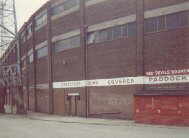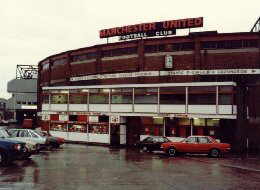RED DEVIL "Manchester
United FC History by Picture"
Note: click on all historical images to see original, larger size
RED DEVIL "Manchester
United FC History by Picture"
 1931
1931 
The Cliff. The picture shows a Rugby League 1st Round
Lancashire Cup match
between Broughton Rangers and Wigan in October
1931. The stand to the right
is where the pavilion is located today.
Broughton Rangers RL club moved to the Cliff in 1913.
It was formerly a cricket
and tennis ground. In 1921 there were 21,000 at the RL
Challenge Cup final between
Leigh and Halifax, and in 1931/32 26,471 saw Salford
v. Swinton in the Lancashire
Cup final. An international (England 11 Wales 8) was played
there on 6 April 1927
in front of 6,700.
In 1933 Broughton Rangers moved to Belle Vue (the
old zoo park, where they
played at the speedway stadium). Belle Vue had covered
seating for 20,000,
and a crowd of 34,000 saw a Britain v. Australia game
in 1933 - nothing to do
with United, but Mancunians with memories of days at
the zoo may find that
of interest. Broughton Rangers became Belle Vue Rangers
in 1946, but folded
in 1955.
United bought the Cliff in 1951 and staged an amateur
RL international between
Britain and France under floodlights in 1952. The lights
were later sold to
Workington FC at Borough Park.
The first photo shows a train passing the old main
stand just before the start of
the last war. That stand is more often seen in pictures
after the Luftwaffe had
finished with it. Despite United's non-entity status
in those days, Old Trafford
looks an impressive arena.
The post-Munich team group shows:
Charlton, Goodwin, Gregg, Carolan, Greaves, Cope, Morgans,
Quixall, Violett, McGuniness, Scanlon.
 1970
1970  1980
1980
The classic forecourt picture (right) with
the souvenir shop before it moved
across the forecourt (into what was once the
Development Association),
and (left) a view of the Stretford
End with a little red hut in the corner,
by the Stretford paddock turnstiles. The little
red hut was, of course, a
souvenir outlet. The connection is that before the main
souvenir
shop was built, the little red hut used to stand in its
position under the Munich
clock (when the clock was on the corner).
TO BE CONTINUED..........